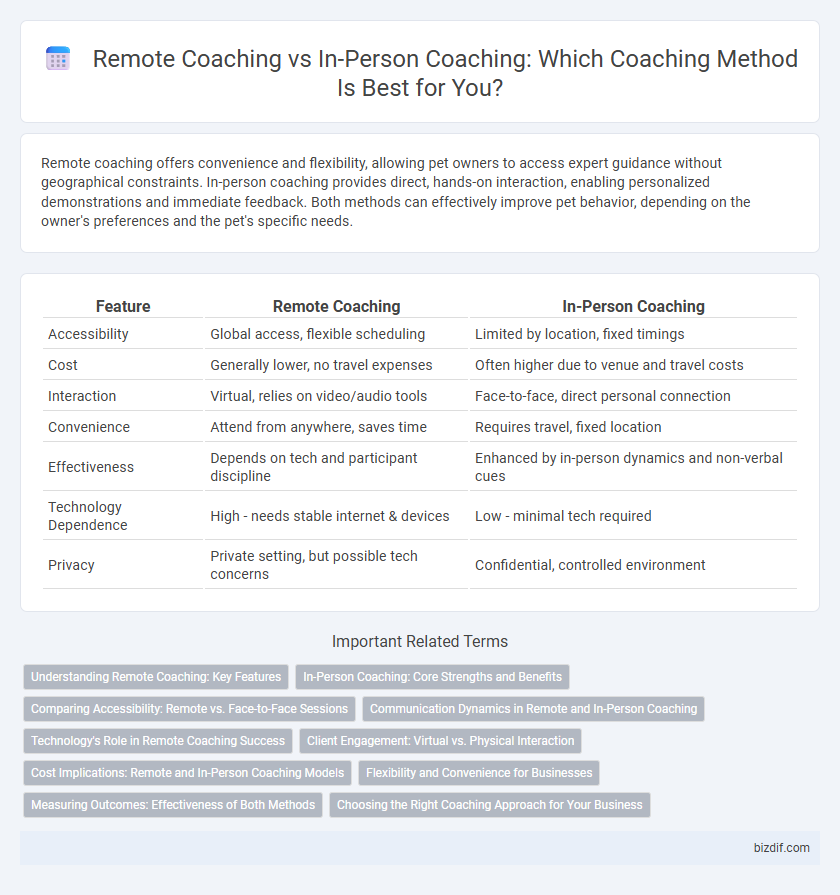Remote coaching offers convenience and flexibility, allowing pet owners to access expert guidance without geographical constraints. In-person coaching provides direct, hands-on interaction, enabling personalized demonstrations and immediate feedback. Both methods can effectively improve pet behavior, depending on the owner's preferences and the pet's specific needs.
Table of Comparison
| Feature | Remote Coaching | In-Person Coaching |
|---|---|---|
| Accessibility | Global access, flexible scheduling | Limited by location, fixed timings |
| Cost | Generally lower, no travel expenses | Often higher due to venue and travel costs |
| Interaction | Virtual, relies on video/audio tools | Face-to-face, direct personal connection |
| Convenience | Attend from anywhere, saves time | Requires travel, fixed location |
| Effectiveness | Depends on tech and participant discipline | Enhanced by in-person dynamics and non-verbal cues |
| Technology Dependence | High - needs stable internet & devices | Low - minimal tech required |
| Privacy | Private setting, but possible tech concerns | Confidential, controlled environment |
Understanding Remote Coaching: Key Features
Remote coaching leverages digital platforms like Zoom, Skype, and specialized apps to facilitate real-time interaction between coaches and clients regardless of geographical barriers. It offers flexibility in scheduling, access to a broader range of coaching styles, and the ability to utilize multimedia resources for personalized sessions. Key features include seamless communication tools, progress tracking dashboards, and the integration of asynchronous feedback, enhancing the overall coaching experience.
In-Person Coaching: Core Strengths and Benefits
In-person coaching fosters deeper interpersonal connections through real-time, face-to-face interactions, enhancing communication and trust between coach and client. The physical presence allows personalized feedback, body language observation, and immediate adjustments, which improve the effectiveness of skill development. Moreover, in-person coaching creates a dedicated environment free from home-based distractions, increasing focus and accountability for the coachee.
Comparing Accessibility: Remote vs. Face-to-Face Sessions
Remote coaching offers unparalleled accessibility by eliminating geographic barriers, allowing clients to connect with experts worldwide through video calls and digital platforms. In-person coaching requires physical presence, which can limit availability due to travel time, location constraints, and scheduling conflicts. Digital accessibility enhances flexible scheduling and accommodates diverse time zones, making remote coaching a more convenient option for many clients.
Communication Dynamics in Remote and In-Person Coaching
Remote coaching relies heavily on digital communication tools, which can limit non-verbal cues and create potential misunderstandings. In-person coaching benefits from richer facial expressions, body language, and immediate feedback, enhancing rapport and trust between coach and client. Effective remote coaching requires deliberate strategies to overcome these communication barriers and maintain engagement and clarity.
Technology's Role in Remote Coaching Success
Technology plays a crucial role in the success of remote coaching by enabling seamless communication and real-time feedback through video conferencing platforms, chat applications, and collaborative tools. Advanced analytics and AI-driven insights enhance personalized coaching strategies by tracking progress and adapting sessions to individual needs. Reliable internet connectivity and user-friendly interfaces ensure accessibility and engagement, making remote coaching as effective and flexible as in-person sessions.
Client Engagement: Virtual vs. Physical Interaction
Client engagement in remote coaching leverages digital tools like video conferencing, chat, and interactive platforms to create flexible, accessible sessions that accommodate diverse schedules. In-person coaching fosters deeper physical presence and non-verbal cues, enhancing trust and immediate feedback through face-to-face interaction. Both methods rely on active participation and tailored communication strategies to maximize client motivation and accountability.
Cost Implications: Remote and In-Person Coaching Models
Remote coaching typically reduces costs by eliminating travel expenses and venue fees, making it a more budget-friendly option for clients and coaches alike. In-person coaching often involves higher overhead due to facility rentals, commuting time, and potential accommodation costs, increasing the overall price of sessions. Both models offer distinct financial implications, with remote coaching providing greater affordability and accessibility while in-person coaching may justify higher costs through personalized, face-to-face interactions.
Flexibility and Convenience for Businesses
Remote coaching offers unparalleled flexibility for businesses by enabling seamless scheduling across different time zones and reducing the need for travel, which saves both time and costs. In-person coaching provides structured, face-to-face interactions that can foster deeper connections but often requires significant logistical planning. Businesses benefit from remote coaching's convenience, allowing employees to engage in sessions from any location while maintaining productivity and minimizing disruptions.
Measuring Outcomes: Effectiveness of Both Methods
Remote coaching utilizes digital tools and virtual communication to track progress through data analytics, enabling real-time adjustments and personalized feedback. In-person coaching offers direct observation and immediate interaction, facilitating nuanced understanding of client emotions and behaviors. Studies indicate that outcome effectiveness of both methods is comparable, with remote coaching showing particular strength in accessibility and consistency of follow-up.
Choosing the Right Coaching Approach for Your Business
Selecting the ideal coaching method depends on your business goals, team dynamics, and resource availability. Remote coaching offers flexibility and access to global expertise, enhancing scalability and cost efficiency. In-person coaching fosters deeper personal connections and immediate feedback, proving effective for hands-on skill development and team cohesion.
Remote Coaching vs In-Person Coaching Infographic

 bizdif.com
bizdif.com